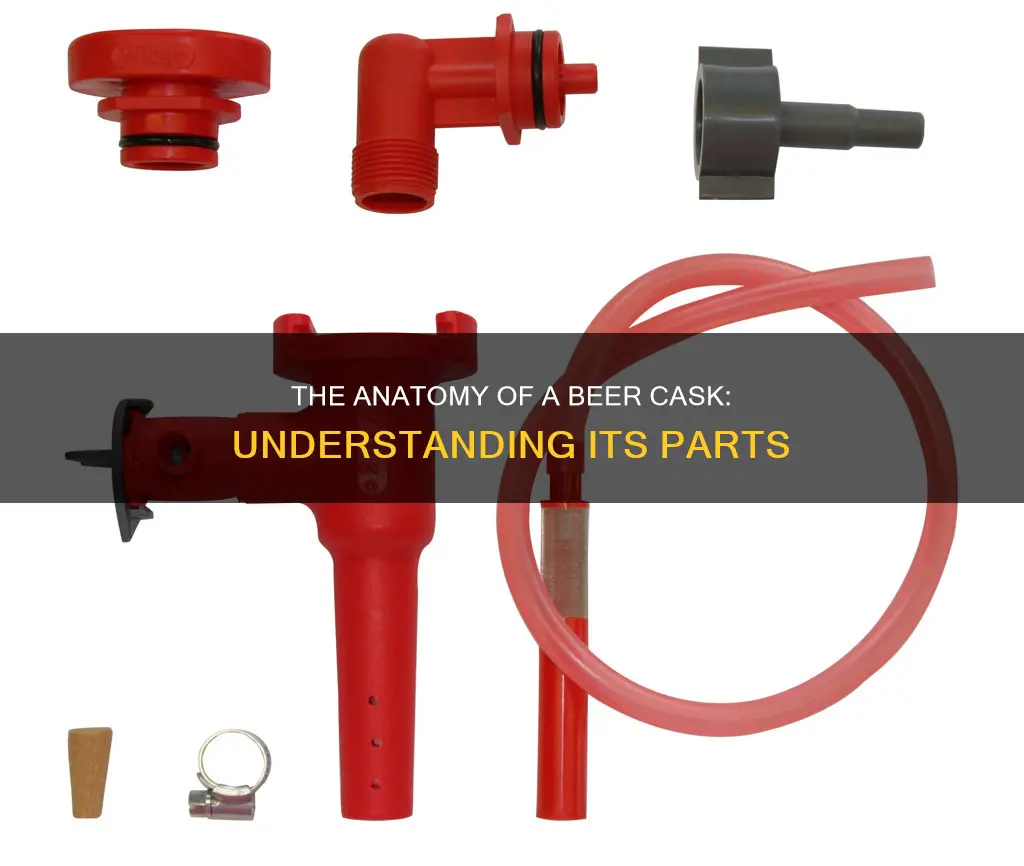
Cask beer, also known as cask ale or real ale, is different from kegged beer in terms of taste, storage, and dispensing. Cask beer is a fresh product that requires conditioning when delivered to a pub cellar, whereas kegged beers are usually pasteurized or sterile filtered and ready to be dispensed immediately. Cask beer is dispensed from a cask, which is the original keg used to preserve and store beer. The cask has two holes: one for the plug (shive) and another for the keystone (where the beer is tapped). A spile is a small wooden peg nailed into the shive to control the carbonation level, and a spigot is used to tap the conditioned beer. These parts (shive, spile, keystone, and spigot) are required for cask ale dispensing and are sometimes sold together as a cask dispense kit.
Characteristics of a Beer Cask and its Parts
| Characteristics | Values |
|---|---|
| Cask | A barrel-shaped container used for the production, storage, and service of cask-conditioned beer. Modern casks are usually made of stainless steel, but can also be made of aluminium or plastic. |
| Shive | A small plastic or wooden plug that is pounded into the cask's large bunghole to seal it. |
| Spile | A small wooden peg nailed into the shive to control carbonation levels. There are two types: hard spiles and soft spiles. |
| Keystone | A small plastic part pounded into the top (outlet) of a cask before tapping. The centre is deliberately weakened to allow the tap to be driven through. |
| Spigot | Pounded into the keystone using a mallet, allowing the conditioned beer to be tapped. |

Cask shape and history
Cask beer, also known as cask ale or real ale, has been brewed for hundreds of years. It is a type of beer that is served directly from a cask without the addition of nitrogen or carbon dioxide, the gases used in any standard draft beer system. The beer is served by gravity, without the use of carbon dioxide pressure, and is unpasteurised, unfiltered, and naturally conditioned.
The history of cask beer can be traced back to the early days of brewing, when beer was brewed mainly for local consumption by small producers, including dedicated brewing businesses, brewhouses in pubs, institutions, and large country houses. With the spread of hops in the 16th and 17th centuries, brewers were able to exploit the antiseptic and stabilising properties of hops, along with high alcohol levels, to create beers that could be kept for several years. This was particularly important during warmer weather when controlling fermentation was challenging.
In the 18th century, large-scale industrial brewers built their businesses on these strong, long-matured beers, sometimes ageing porters and pale ales in wooden barrels and tuns for two or more years. This lengthy ageing process resulted in a flavour profile similar to Belgian sour brown ales or craft-brewed farmhouse ales. However, tastes shifted in the 19th century towards lighter, fresher "mild" products. License deregulation in 1830 led to a proliferation of home-brewing beer houses that lacked the resources for long ageing and instead focused on fresher styles. Technological advancements, particularly in microbiology, made brewing these lighter beers easier. Improvements in transport also allowed for shipping beers over longer distances in a shorter time.
The early 20th century saw a near-complete shift from matured beers to fresh, mild beers, with brewers noting the distinction between true secondary fermentation in matured beers and the continuation of initial fermentation in cask beers. Despite expectations that the market would favour highly carbonated bottled beers, consumer resistance to pasteurised, force-carbonated keg beers in the mid-20th century led to the resurgence of the cask format.
Today, cask ales are typically served in traditional pub glasses known as "pints", although some breweries offer smaller servings to allow for responsible drinking. Cask ales are best enjoyed during the winter months, as they are served at cellar temperature (10-14°C).
Hard Cider vs Beer: What's the Difference?
You may want to see also

Cask materials
Today, most casks are made from stainless steel, but they can also be made from aluminium or plastic. The grade of stainless steel used for casks is important to avoid corrosion. Plastic casks are often made of a laminate of materials and must be impervious to air and impart no flavour to the beer. Aluminium is no longer used to make casks due to the difficulty of cleaning it with alkaline solutions, although some aluminium casks remain in use in the UK.
The standard sizes of a cask for real ale are 9 gallons and 4.5 gallons. Casks in the UK are measured in imperial gallons, with the most common size being the firkin, which contains 9 imperial gallons (72 pints). Other sizes include the kilderkin, which is twice the size of the firkin, the barrel, which is four times the size, and the hogshead, which is six times the size.
The Many Shades of Blue Moon Beers
You may want to see also

Cask openings
The cask itself is the original keg used to preserve and store beer. Casks have been used for at least a thousand years, and while they were traditionally made of wood, today they are usually made of stainless steel. The standard sizes of a cask for real ale are 9 gallons and 4.5 gallons. Casks feature two holes: a 2-inch hole for the plug (or shive) to regulate the conditioning process, and a 1-inch hole for the keystone (where the beer is tapped).
The shive is a small plastic or wooden plug that is pounded into the large bunghole on the belly of the cask. It has a thinly sealed hole in the centre, which is used to regulate the beer's condition (CO2 level). A hard spile, or small wooden peg, is inserted into the hole in the shive after the conditioning process to maintain carbonation levels.
The keystone is a small plastic part that is pounded into the top (outlet) of the cask before it is tapped. A spigot is softly pounded into the keystone using a mallet, allowing the conditioned beer to be tapped and dispensed.
What's the Real Difference in Draft Beer?
You may want to see also

Cask plugs
Before a cask can be tapped, it undergoes a second fermentation in the cellar of the pub, which creates carbon dioxide (CO2) and requires the cask to be vented. The shive, or cask plug, is pounded into the cask to facilitate this venting process, allowing the excess CO2 to escape and regulating the conditioning of the beer.
Shives are typically made of plastic and are designed to be pounded or hammered into the cask securely. They work in conjunction with spiles, which are small wooden pegs nailed into the shive. There are two types of spiles: hard spiles and soft spiles. Hard spiles are used after the conditioning process to maintain carbonation levels, while soft spiles replace the hard ones once the cask is tapped to help release any remaining excess CO2.
The combination of the shive and spile plays a crucial role in controlling the carbonation and ensuring the beer is properly conditioned before serving. Together, these components contribute to the unique taste and freshness of cask ale, which is highly perishable and should be consumed within 48 hours of tapping.
Exploring the Diverse US Beer Scene
You may want to see also

Dispensing methods
Cask ale, also known as real ale, is served directly from a cask without the addition of nitrogen or CO2, which are used in standard draft beer systems. The absence of these gases and the addition of live yeast allow the cask ale to undergo a brief secondary fermentation process within the cask, making the beer richer in flavour. Once tapped, the beer must be consumed within 48 hours as it is highly perishable.
There are two main ways to dispense cask ale: using a spigot attached to the cask or by pumping the beer by hand using a Pullman beer engine. The spigot method involves pounding a spigot into the cask's keystone using a mallet, allowing the beer to flow via gravity. The beer engine, on the other hand, is a more sophisticated method that involves drawing beer directly from the cask through a beer line. These hand pumps are usually manually operated but can also be gas or electrically powered. They are typically hidden under the bar counter, with only the handles visible. Some beer engines include a sparkler that attaches to the nozzle, creating a showerhead effect that froths the beer and gives it a nice head.
To ensure proper cask ale dispensing, four parts are required: the shive, spile, keystone, and spigot. The shive is a small plastic or wooden plug pounded into the cask's large bunghole to seal it. The spile is a small wooden peg nailed into the shive to control carbonation levels. There are two types of spiles: hard spiles, used after conditioning to maintain carbonation, and soft spiles, used after tapping to release excess CO2. The keystone is a small plastic part pounded into the cask's tap hole, and the spigot is softly pounded into the keystone to tap the conditioned beer.
Exploring Samuel Adams' Diverse Beer Flavors
You may want to see also
Frequently asked questions
A cask is a barrel-shaped container used for the production, storage, and service of cask-conditioned beer, also known as "real ale". Casks have been used for over 2,000 years, originally made of wood but now typically made of stainless steel.
The main parts of a beer cask include the cask itself, the shive (a plastic or wooden plug), the spile (a small wooden peg), the keystone (a small plastic part), and the spigot (a tap).
Cask beer, or real ale, undergoes a second fermentation process and is served straight from the cask without the addition of nitrogen or CO2. The beer is tapped and poured directly from the cask, or pumped using a beer engine.







